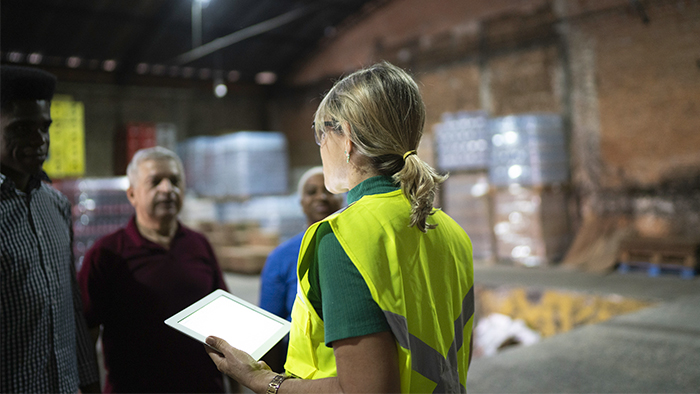Compliance Leadership Model
- By [ Tiffin Shewmake ]
- 09/14/2017
Programs designed for more than just baseline compliance can add additional value to the organization and even save money. For example, to reduce the risk of delayed permits, a retailer may identify the most common compliance requirements for equipment such as emergency generators before purchasing and installing. A program with processes to identify future or likely risks helps an organization make better decisions and reduces risk and potential disruptions. Likewise, a program that incorporates more sustainable thinking into compliance programs has the potential to reduce compliance obligations as well as environmental impacts.

Another benefit of a compliance program is to communicate the organization’s focus on compliance both internally and to external stakeholders. This can help build a culture of compliance as well as provide a positive starting point for working with regulatory agencies. Most inspectors and agencies appreciate organizations that have put thought and effort into building systems to ensure compliance and factor that into their decision making. Compliance programs that include sustainability also help document an organization’s commitment to environmental protection, which can have a positive impact on perceptions about the company.
But…there are challenges. Detailed compliance programs don’t spring out of the store aisles by themselves. Program design and implementation can be time consuming and expensive, and maintenance takes continuing commitment. The good program today can be ineffective in a fairly short time. Getting management attention and resources can be difficult, especially in an industry such as retail with low margins and few obvious immediate environmental hazards. Communicating the value of avoided potential enforcement and costs is not as easy as documenting direct expenses. Also difficult is evaluating program effectiveness and determining if resource levels are right.
The Retial Compliance Center designed the Compliance Leadership Model (CLM) to help retailers meet these challenges and implement more effective environmental compliance programs. The CLM provides a framework for a retail environmental compliance program so that retailers don’t have to start from scratch or worry about knowing all the elements of an effective program. Using the CLM, retailers can benchmark their programs, internally and with their peers, to help answer questions about appropriate program levels and resources. The CLM is also designed to help retailers optimize their programs to reduce risk and look for ways to find value in the program.
The CLM dimensions are built around widely accepted compliance program standards. These include International Organization for Standardization (ISO) 14001: Environmental Management Systems and ISO 19600: Compliance Management Systems, as well as the U.S. Federal Sentencing Guidelines from the 2016 Guidelines Manual, Chapter 8, Section 2 on “Effective Compliance and Ethics Program.” The first CLM level, Level 1-Essential sets out a minimum compliance program that all organizations should implement. The other levels provides additional elements to help organizations optimize their program to reduce regulatory risks and improve environmental performance. In this way the CLM is somewhat like, but not identical to, the standard maturity model. Unlike a maturity model, not every retailer will need or want to increase the level of their program for every dimension.
At Level 1: Essential, the focus is on compliance with regulations and not optimization or reducing environmental impacts. Depending a company’s regulatory risk, Level 1 may be the appropriate level for many of their operations. For example, an Essential hazardous waste program would be appropriate for a clothing store with only a few items, perhaps perfume and batteries, that might be considered hazardous waste if unsalable.
The subsequent CLM levels: Level 2-Structured, Level 3-Optimized and Level 4-Proactive reflect programs that are increasingly standardized across the organization and the increasing integration of environmental compliance into other compliance programs and eventually into the business strategy of the organization. In addition, organizations start to look at how to optimize their programs to be more efficient and to reduce or even eliminate compliance obligations. For retailers with many products that have the potential to become hazardous waste, this could include data analysis to identify best practices in identifying and handling hazardous waste. A step further would be to look at reducing the volume of hazardous waste—either by reducing items that become waste, for example by reducing breakage or incidence of expired products or work to reduce products that are potentially hazardous waste. The goal moves from just compliance to reducing requirements and making programs more efficient.
In the higher levels, the focus goes beyond compliance to include reducing environmental impacts and ultimately to life cycle approaches. For example, an organization’s storm water program at Level 1- Essential focuses on complying with minimum storm water requirements in specific jurisdictions, i.e., to implement the minimum stormwater controls required for any given area. Organizations at the structured level start to implement common stormwater controls across all of their facilities but still with a focus on compliance. At the Optimized and Proactive levels, organizations look at not just compliance but also how to reduce stormwater impacts and may decide in some areas to go beyond compliance. In practice, this might be to implement green building standards at all sites to minimize or even completely reduce stormwater runoff. At the Proactive level, a company may also work to restore water bodies or wetlands in sensitive areas.
How to use the CLM
Retailers can use the CLM to evaluate and improve their current program and benchmark with other retailers. The initial CLM consists of a benchmarking survey and reports. Retailers can use the survey to conduct a self-assessment and set goals. For example, a company may have a good system for tracking compliance obligations and judge that they are at Level 3: Optimized in this area but realize that they do not have a similar program for understanding environmental impacts. They may decide to set a goal to implement a level 3 program for environmental impacts to stay competitive and increase the likelihood of being prepared for unexpected issues.
For internal benchmarking, retailers can take the survey for different company areas such as function (stores or distribution centers), regions, or different banners. This can help identify places which may need additional resources or are implementing best practices that could be replicated across the organization.
After taking the survey, Companies will get a benchmarking report that shows their answers and also their peers’ responses. Specific company information is confidential and only shared with the company (i.e., only sent to the individual identified as the main contact on the survey). Benchmarking comparisons are against the average responses for their peer group, generally based on store format. Companies can use the benchmarking to evaluate their goals and decide if their resources are appropriately allocated or if their approach is helping differentiate their brand, especially for companies at or with goals for the Proactive level.
The CLM is designed to work with the RCC’s Retail Environmental Management System (EMS) Guidance. This material, based on ISO 14001, is customized for the retail industry and can used for more in-depth gap analysis of programs and to develop or update an EMS. The material also includes tools and sample documents that can be customized.
The RCC is developing an automated version of the CLM, with personalized company dashboards so that users can see their CLM response, track performance towards goals and view benchmarking results without having to wait for a static report. The system will also provide suggested resources to help companies move from one level to the next. The RCC is also planning to implement this approach for the Retail Sustainability Leadership Model and the Retail Energy Management Leadership Model, enabling users to seamlessly view their performance over these programs. Because the CLM is based on standard compliance program elements, it the future it can be implemented for other compliance areas such as safety.
The RCC is a free resource for the retail industry focused on providing resources and tools to help retailers comply with environmental regulations.
Additional Resources
Compliance Leadership Model
Compliance model intended to help retail companies optimize and benchmark environmental compliance programs.
Environmental Management Systems (EMS) for Retail
Guidance on how to optimize or develop an Environmental Management Systems in the retail industry.



